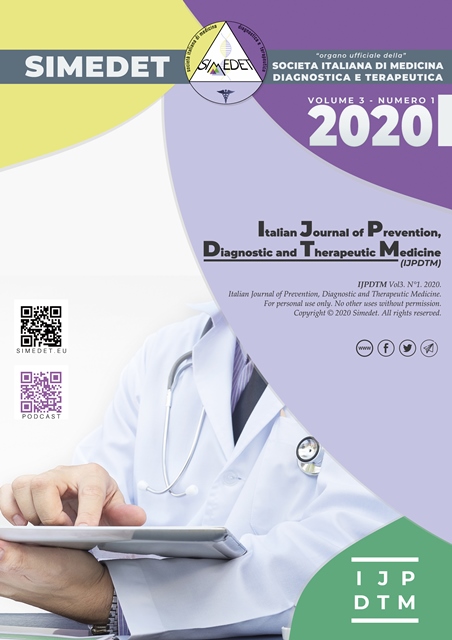The Prevention analyzed through the perspective of personal habits
Main Article Content
Abstract
Habits may be the keyword in the future of health.
In the last years scientist have demonstrated that habits have a great importance on peoples’ future.
Factors such as a sedentary lifestyle, abuse of processed food, and deterioration of the social life and the environment are putting a strain on the adaptability of the human body.
New chronic diseases are replacing the old ones and imposing very high social and health costs.
New educational tools and awareness of the original habits’ value can allow a sustainable and effective health care.
Downloads
Article Details

This work is licensed under a Creative Commons Attribution-NonCommercial-NoDerivatives 4.0 International License.
References
Cohen S, Janicki-Deverts D, Miller GE. Psycological stress and deseases. Jama 2007; 298(14):1685-87.
Rapporto nazionale Passi 2013: diabete. http://www.epicentro.iss.it/passi/
Osservatorio ARNO diabete. Il profilo assistenziale della popolazione con diabete. Rapporto 2015. Volume XXIII.
AAVV. La salute nelle regioni italiane. Bilancio di un decennio (2005-2015). ISTAT 2019 ISBN 978-88-458-1970-4
De Mei B, Cadeddu C, Luzi P, et al. Movimento, sport e salute: l’importanza delle politiche di promozione dell’attività fisica e le ricadute sulla collettività. Istituto Superiore di Sanità – Rapporto ISTISAN. 18/9 - 2018, ii, 95 p.
Carlsson-Kanyama A, González AD. Potential contributions of food consumption patterns to climate change. Am J Clin Nutr. 2009;89(5):1704S-1709S.
Salter AM. The effects of meat consumption on global health. Rev Sci Tech. 2018;37(1):47-55.
Avena NM, Rada P, Hoebel BG. Evidence for sugar addiction: behavioral and neurochemical effects of intermittent, excessive sugar intake. Neurosci Biobehav Rev. 2008;32(1):20-39.
Calder PC, Albers R, Antoine JM, et al. Inflammatory disease processes and interactions with nutrition. Br J Nutr. 2009;101 (Suppl 1):S1-45.
Colombo E, Senn L. I costi economici e sociali della sedentarietà. med. sport 2015;68(2):345-56
AAVV. Global action plan on physical activity 2018-2030: more active people for a healthier world. Geneva: World Health Organization; 2018. Licence: CC BY-NC-SA 3.0 IGO.
Cinzano P, Falchi F, Elvidge CD. The first World Atlas of the artificial night sky brightness, Mon. Not. R. Astron. Soc. 2001;328(3):689-707.
Pauley SM. Lighting for the human circadian clock: Recent research indicates that lighting has become a public health issue. Med. Hypothes. 2004; 63:588–96.
Navara KJ, Nelson RJ. The dark side of light at night: physiological, epidemiological, and ecological consequences. J Pineal Res. 2007;43(3):215-24.
Renard G1, Leid J. The dangers of blue light: True story! J Fr Ophtalmol. 2016;39(5):483-8.
Palermo S. Anticipazione dolorifica. Una possibile via per lo studio dei correlati neurali dell’effetto nocebo. Rivista internazionale di Filosofia e Psicologia, 9(3):259-279.
Amanzio M, Palermo S. Nocebo effects and psychotropic drug action - an update. Expert Rev. Clin. Pharmacol. 2020 in pubblication https://doi.org/10.1080/17512433.2020.1722100
Evers AWM, Colloca L, Blease C, et al. Implications of Placebo and Nocebo Effects for Clinical Practice: Expert Consensus. Psychother Psychosom. 2018;87(4):204-10.
Morese R, Lamm C, Bosco FM et al. Social support modulates the neural correlates underlying social exclusion. Soc Cogn Affect Neurosci. 2019; 14(6): 633-643.
Morese R, Palermo S, Defedele M et al. Vulnerability and Social Exclusion: Risk in Adolescence and Old Age. In: Morese, Palermo. The New Forms of Social Exclusion. IntechOpen Limited 2019; 2: 11-26.
Thaler RH, Sunstain CR. Nudge. La spinta gentile. La nuova strategia per migliorare le nostre decisioni su denaro, salute, felicità. Universale Economica Feltrinelli, 2014.
Palermo S, Morese R. Introductory Chapter: Neuroscience wants Behaviour. In: Palermo, Morese. Behavioral Neuroscience. IntechOpen 2019; 1:3-8.
Blair SN. Phisical fitness and all-cause mortality. A prospective study of health men and women. Jama 1989; 262(17):2395-401.
AAVV. Linee di indirizzo sull’attività fisica per le differenti fasce d’età e con riferimento a situazioni fisiologiche e fisiopatologiche e a sottogruppi specifici di popolazione. Ministero della Salute Direzione Generale della Prevenzione Sanitaria. 2019.

